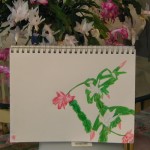INTUITIVE FOCUSING: OVERCOMING ANXIETY, DEPRESSION, OVERWHELM, AND NUMBNESS CAUSED BY AN OVERLOAD OF NEGATIVE SITUATIONS
Complete Focusing Instructions Manual (17 pages)
“Ajas” Instantaneos Mini-Manual
SITUATION PILE UPS AND NEGATIVE SPIRALS
Intuitive Focusing is a meditation-like practice which allows you to sort through your thoughts and emotional reactions by paying attention to the way in which your “physical body” and your larger “intuitive, gut feel” hold information needed for problem solving.
I can use Intuitive Focusing for “sensing into” the “intuitive feel” left by situations to clear my inner space, sort through meanings, and come up with action steps many times a week. However, there are two other inner events related to outer situations and interactions that are harder to unravel. I call them “situation pile ups” and “negative spirals.”
SITUATION PILE UPS
Sometimes I find myself feeling overwhelmed, or maybe numb, like concrete, or stiffened from stress and anxiety. When I find time to gently “sit with” the “feel of it all,” I can start to unravel what may have been a “situation pile up.” The final feeling state is the result of several situations or incidences during the week where the “felt residue” went unnoticed and unattended to. Hence, the “pile up” into complete overwhelm or numbness.
Please download the “Complete Focusing Instructions” from the link above so you have access to the exercises I refer to below.
Perhaps starting with a Relaxation Exercise like #1. Noticing (p. 3) or #4. Counting Meditation (p.6), I might then move to Felt Sensing # 3, Clearing a Space (p. 10 in Complete Focusing Instructions).
Clearing A Space
As I ask myself, “What is between me and feeling totally okay?”, I can sit silently, eyes closed, with each issue or situation or interaction that arises, notice the “bodily-felt sense” of “that whole thing,” take a moment to find a “handle” word for it, then set it outside of me (ahhhhh!). Eventually, I will find a cleared space inside and be able to say, “Except for all of that, I am totally okay.” I will realize that a series of unresolved situations or interactions have “piled up.” I can now choose to take them one at a time and use Instant Ahah #1, Focusing: Find Out What Is Bothering You, to go more deeply into problem resolution.
NEGATIVE SPIRALS
Similarly, I might find myself falling into negative statements and beliefs about myself, saying “I am so stupid,” “Nobody wants me,” “There is something terribly wrong with me,” “I never do anything right,” etc. There seems to be a negative spiral, going deeper and deeper into despair and negative thinking.
Again, such a negative spiral can be the end result of a number of situations or interactions that left an unresolved “residue.” In this case, they may all have coalesced around a theme, like “I am worthless.” And again, the solution is to stop and commit some quiet time to Intuitive Focusing.
Start with a Relaxation Exercise, then perhaps Clearing A Space followed by a longer Focusing session (see above for links to these exercises). Simply by sitting with the negative feelings, giving them an empathic hearing, and asking open-ended questions like “What is this all about?”, you can begin to trace the negative feelings back to actual situations and interactions. Now, knowing what really happened, you can begin to look for solutions and action steps.
Especially with overwhelming negative spirals, you will want to use some specific techniques for dealing with the inner Critic and for finding a way to give a negative feeling a voice without falling into it. Ann Weiser Cornell, with her Inner Relationship Focusing methods, has specialized in helping Focusers to “disidentify” from all the various “parts” or “voices” or “aspects” inside, giving each an empathic hearing. You can learn some of these methods in upcoming Level 1 and 2 tele-classes with Ruth Hirsch, an Inner Relationship teacher and Creative Edge Associate.
CREATIVE EDGE FOCUSING(tm): SELF-HELP SKILLS FOR HOME AND WORK
Creative Edge Focusing (www.cefocusing.com ) teaches two basic self-help skills, Intuitive Focusing and Focused Listening, which can be applied at home and at work through The Creative Edge Focusing Pyramid.
Based upon Gendlin’s Experiential Focusing (www.focusing.org ) and Rogers’ Empathic Listening, our website is packed with Free Resources and instructions in these basic self-help skills. Learn how to build Support Groups, Conscious Relationships, and Creative Edge Organizations based upon these basic skills of emotional intelligence.
You can try out “Focusing: Find Out What Is Bothering You.”
Click here to subscribe to Creative Edge Focusing(TM)’s Instant “Ahah!” e-newsletter and get the latest exercises first!!! Today’s blog is part of the year-long e-course offered through the Instant “Ahah!” e-newsletter.
Click here for a free Intuitive Focusing Mini-Course
Click here for a free Focused Listening Mini-Course
See Core Concept: Conflict Resolution to find a complete mini-course on Interpersonal Focusing and Conflict Resolution, including Rosenberg’s Non-Violent Communication, Blanchard’s “One Minute Apology,” Patricia Evan’s books on Verbally Abuse and Controlling Relationships, McMahon’s Beyond The Myth Of Dominance, and much more.
See Core Concept: Intimate Relationship to find a complete mini-course on increasing intimacy and sexuality, including the “Sharing Your Day” exercise, Listening/Focusing Partnerships for The Way of Relationship, untangling and equalizing desire, tantric sexuality, and much more.
Download complete Instant “Ahah!” Mini-Manual, in English and Spanish, from CEF Website, or download from links at top of this blog.
Find links to free articles, personality tests, multi-media Self-Help training, Classes and workshops
Dr. Kathy McGuire, Director


